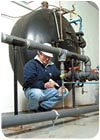
More needs to be done to help small water systems meet regulatory goals. Photo courtesy of White Water Inc.
From our friends at the American Water Works Association:
Despite gains by states and the U.S. Environmental Protection Agency (EPA) in recent years to help small water systems strengthen their capacity to meet federal drinking water regulations, more effort and resources are needed, concludes an internal agency report.
Based on discussions with agency officials at the national and regional levels and primacy agencies, third-party assistance organizations and 19 small systems in three states (Kansas, Maine and Massachusetts), EPA's inspector general documented a litany of known obstacles that continue to plague the almost 46,000 systems serving 3,300 or fewer people.
The report also highlights several success stories, and recommends a series of actions for EPA to take to bolster its small systems assistance efforts, including working closer with states to identify and disseminate small system best practices.
Among the major obstacles facing the small systems cited were well-documented financial and business management challenges, including problems in raising rates to cover capital expenses needed to address aging infrastructure and compliance demands, and difficulties obtaining financial assistance.
Also noted were impediments in getting assistance from the Drinking Water State Revolving Fund (DWSRF), adding that only one of the small systems it reviewed had received a DWSRF loan or grant.
Another key obstacle identified is problematic management and operational staff, many of whom are part-time, poorly paid, prone to high turnover and lack time to conduct long-term planning, and to understand and effectively implement drinking regulations, particularly the newer arsenic and radionuclides rules.
Recognized were the ongoing efforts by EPA, states and third-party partners to help small systems, especially highlighting the value of third-party organizations operating in the three states, including rural water associations, rural community assistance programs, EPA-supported technical assistance centers and the New England Water Works Association.
In directing EPA to help states develop best practices for small systems, the report noted that the Office of Water reported it is developing an improved Web site dedicated to supporting small systems, and that the report includes an agency summary of current and forthcoming small system assistance resources.
The EPA, in fact, just released three guidance documents to help small systems comply with the Stage 1 Disinfection By-products Rule. The package includes a basic guide for all water systems adding chemical disinfectants, as well as supplements for systems using conventional treatment and those adding chlorine dioxide or ozone.
Report Abusive Comment